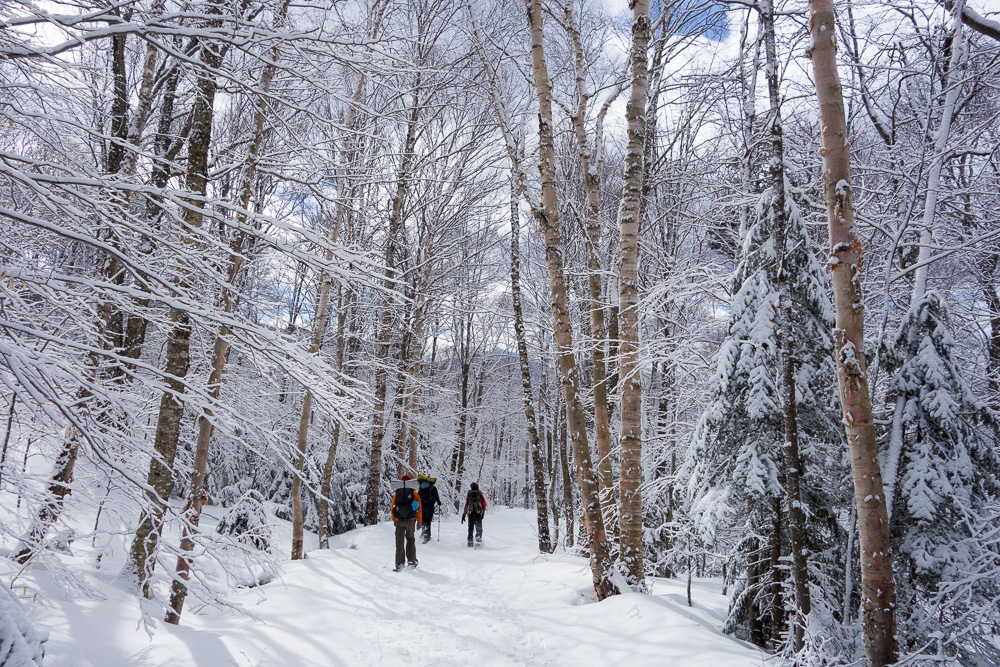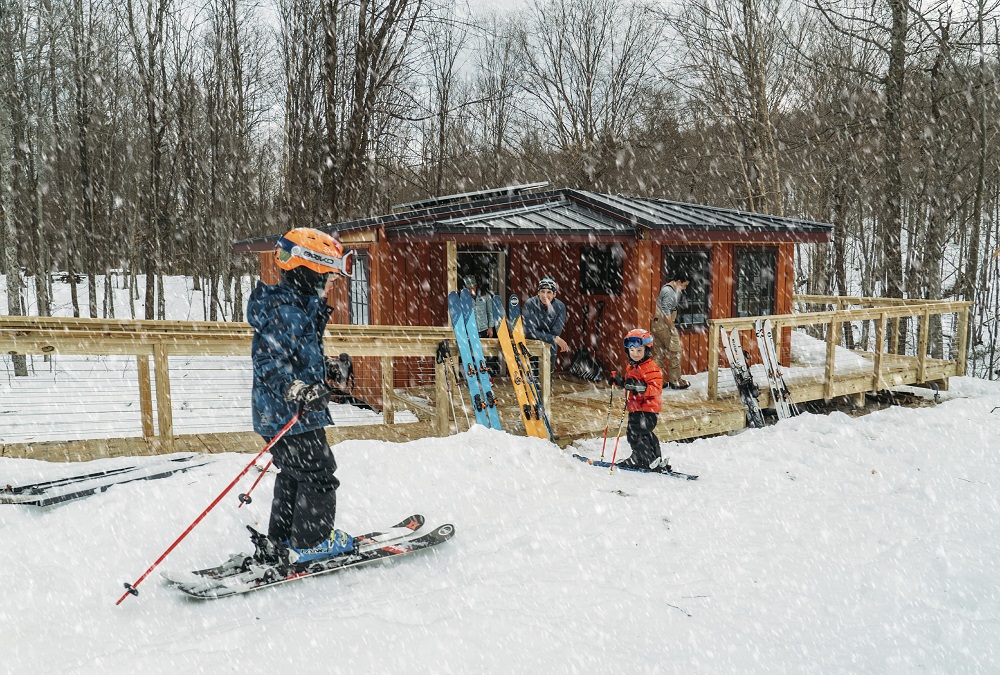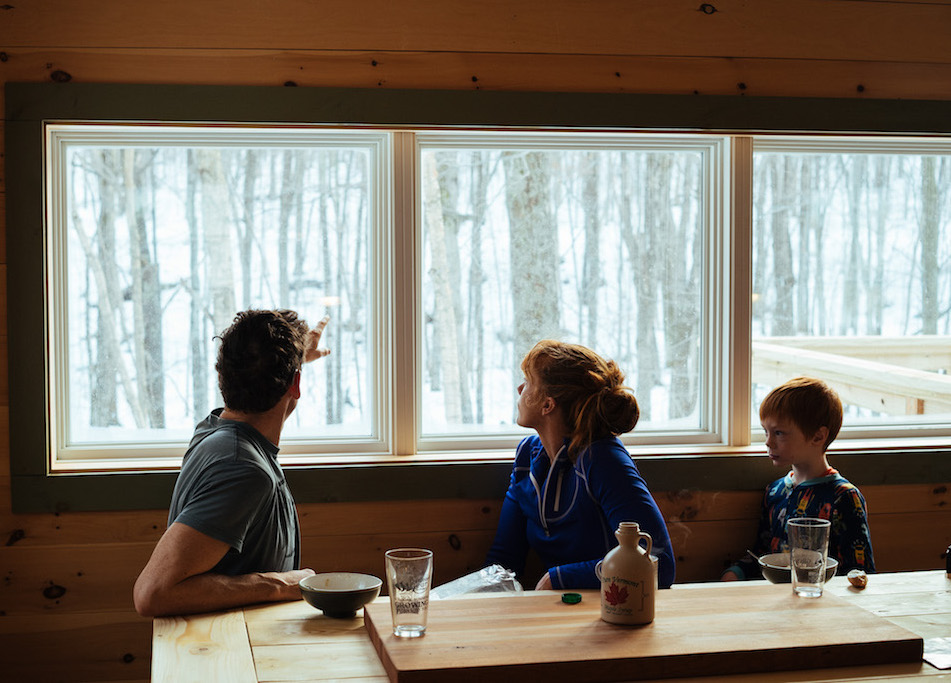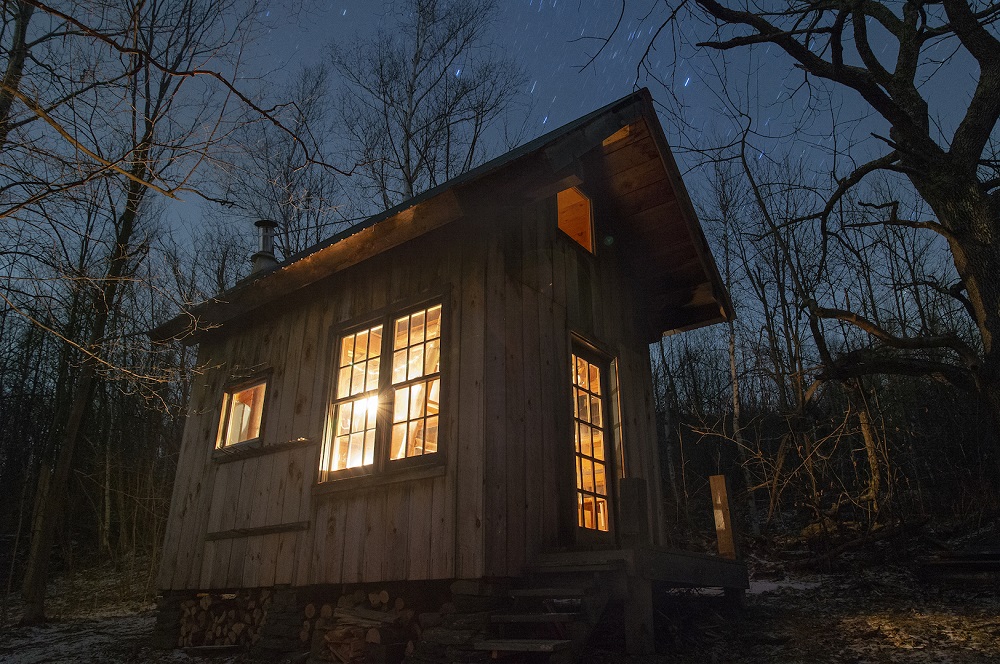This article was written by RJ Thompson, executive director of Vermont Huts Association.
In the Beginning
 When Vermont Huts Association launched in 2016, the idea to create a cohesive hut network in Vermont wasn’t a new one. Various individuals and organizations had contemplated the idea, scribbling notes on napkins and brainstorming grand ideas over a few cold ones. In fact, at least one small group of folks attempted to pull something together as a for-profit business. For whatever reason, the concept never gained any steam.
When Vermont Huts Association launched in 2016, the idea to create a cohesive hut network in Vermont wasn’t a new one. Various individuals and organizations had contemplated the idea, scribbling notes on napkins and brainstorming grand ideas over a few cold ones. In fact, at least one small group of folks attempted to pull something together as a for-profit business. For whatever reason, the concept never gained any steam.
Of course, the Green Mountain Club has created and continues to steward the country’s oldest long-distance hiking trail and shelter system. Aside from the Long Trail itself, the knowledge and experience swirling around the GMC headquarters on any given day is perhaps one of Vermont’s greatest assets. So it made complete sense that, from the beginning, Dave Hardy, former director of trail programs at GMC, was tapped for his brainpower and valued opinions regarding a conceptual hut network. GMC board member Amy Kelsey, former executive director of the Catamount Trail Association, was also involved from the start, and she continues to serve as a VT Huts board member.
At our first informal meeting in July 2016, before VT Huts was established as a 501(c)(3), no one really knew what the outcome might look like. Lots of ideas were discussed:
Should this be a year-round, multi-use hut system? Yes. Could the Catamount Trail Association or Green Mountain Club take on this initiative? This question was debated for about 20 minutes. The consensus was that it would be a bit of a mission drift for either organization to begin focusing their efforts on ways to connect skiers, hikers, and mountain bikers. Vermont’s landscape and trail networks are comprised of private, municipal, state, and federal landowners, and while the existing trail organizations had plenty of experience operating in those realms, developing a new hut network that would not only span various geographic boundaries, but also different user-group interests, seemed like it needed its own home.
So the decision was unanimous. A new nonprofit was needed, and it would be called the Vermont Huts Association.
Early Success
Things have been a blur since then. Immediately following that meeting, Devin Littlefield (at the time a recent transplant from Maine) and I began work in earnest. We set up meetings with numerous stakeholders including trail chapters, public land managers, and just about anyone who was willing to hear us talk about huts. Hours were spent poring over maps, imagining conceptual hut locations and possibilities for new trail connectivity. Slowly, we began to see how a connected hut system could serve multiple user groups year-round. With our initial focus on connecting the rural communities and existing trail networks between the resort towns of Killington and Stowe, we were eager to identify our first project.
And then, magically, just one short year after our first informal meeting, we were presented with an opportunity. Green Mountain National Forest’s Rochester District was conducting its Robinson Integrated Resource Project (IRP) on a large tract of land that included the possibility to site a new four-season hut at the Chittenden Brook Campground, just two trail miles from the recently completed Brandon Gap backcountry zones. At the same time, the Yestermorrow Design/Build School in Waitsfield, VT, was looking for a client for their annual semester program, and a hut project would be a perfect fit for the students. The stars had seemingly aligned, but we literally had less than $10,000 in our bank account. How the heck was such a young and pretty much unknown organization going to pay for a hut upwards of $100,000?
The truth is, we didn’t know. But we had a growing number of members supporting our initiative, and if we continued to simply talk about a concept, it would remain just that. We needed to sink our teeth into a project and build on the momentum created over the past year.
Fortunately, we were able to bring the project to completion thanks to myriad donors, members, foundations, and an incredible crew of volunteers who literally worked in blizzards and walked through knee-deep snow to put the finishing touches on the hut. On December 1, 2018, the first guests spent a night in Vermont’s newest, ADA-compliant backcountry facility.

Moving Forward
 Our little organization now boasts seven partner hut destinations across the state of Vermont, plus our very own Chittenden Brook Hut. Since then, our 660-square-foot flagship hut has seen over 1,000 guests in its first 14 months of operation. A true testament to the old saying, “If you build it, they will come.”
Our little organization now boasts seven partner hut destinations across the state of Vermont, plus our very own Chittenden Brook Hut. Since then, our 660-square-foot flagship hut has seen over 1,000 guests in its first 14 months of operation. A true testament to the old saying, “If you build it, they will come.”
And this new decade brings new opportunities. Throughout 2019, as a result of numerous site visits all over the state, we have accumulated a pipeline of 11 potential hut projects and growing. That includes a mix of existing huts on private and public land as well as two locations where we would construct new facilities.
Not all of those projects will come to life in 2020, and some may never be fully realized due to a number of factors (bad site, structural integrity, etc). However, with that many opportunities, we will have a busy year to say the least. It is our goal to construct and open at least one new hut before the end of 2020, and we wouldn’t rule out two. It is also likely that we welcome at least two more private hut operators into the network before the end of 2020. Given the various permits and approvals required before we can break ground, it is still premature to announce the potential location(s) of these huts, but we’ll let you know as soon as all of our ducks are in a row.
In addition to bringing these opportunities to life, we will continue to work with our partners in recreation at the state and federal level, as well as our friends at the Catamount Trail Association, Green Mountain Club, and Vermont Mountain Bike Association to ensure our efforts align, particularly on the Velomont Trail efforts (an end-to-end multi-use mountain bike trail linking Vermont’s existing mountain bike chapters).
Huts for All
 A big part of our mission is to make the outdoors more accessible for all Vermonters, so we recently launched the FOREST program (Fostering Outdoor Recreation, Education, Sustainability, and Teamwork), a two-night hut and outdoor experience for underrepresented youth focusing on the natural environment while providing important wilderness survival skills.
A big part of our mission is to make the outdoors more accessible for all Vermonters, so we recently launched the FOREST program (Fostering Outdoor Recreation, Education, Sustainability, and Teamwork), a two-night hut and outdoor experience for underrepresented youth focusing on the natural environment while providing important wilderness survival skills.
In collaboration with Addison Central Teens, Catamount Trail Association, and School of the Forest, with support from VHCB and RiseVT, the pilot program provided essential gear, instruction, meals, transportation, and two nights at Chittenden Brook Hut – all free of charge! Participants also received XC ski instruction to ensure they were able to confidently reach the hut and navigate the surrounding trails with their instructors and chaperones.
We hope this pilot program will set the foundation for future FOREST program opportunities at our other hut locations. It is our goal to grow this program to a point where we are able to offer it at all of our huts at least five times per year. And the more huts we open, the more youth we can serve.
So there you have it. In three short years, we’ve managed to move the hut needle quite a bit in the Green Mountain State. Pockets of hut-to-hut connectivity along the Catamount Trail are emerging in Huntington thanks to our partner operators at Triple Creek Cabin and the Crow’s Nest Yurt, and with one more strategically located hut to the north, it won’t be long until you can continue up to GMC’s Bolton Lodge or Bryant Camp in a reasonable day trip. Once the shovel-ready section of Velomont Trail is constructed between Pittsfield and Rochester, a similar experience will be possible on a mountain bike.
Thanks to the hard work of our partner trail organizations, most of the lines have already been drawn on the map. We just need to connect what’s already there, one hut at a time.

Want to learn more about huts in Vermont? Come to RJ’s Taylor Series talk on Friday, March 6, at 7 P.M. at the Richmond Free Library in Richmond, VT. “Creating a Four-Season Hut Network in the Green Mountains” is hosted by the GMC Burlington Section.



















It would be wonderful if this was open to the equestrian community riding trails in Vermont are few and far between and it is a shame